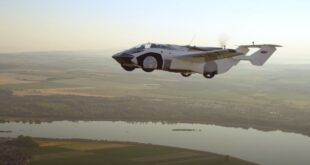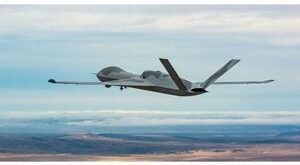By far, the most common use of drones is aerial photography, but as the capabilities of commercial drones have advanced, the applications have become more sophisticated, from 3D mapping to plant inspections.
“We use drones to solve problems and create efficiencies,” says Steve Schleicher, partner and vice president of business development at Pinnacle Engineering. The environmental engineering group has a fleet of 11 drones and multiple cameras and sensors. The two newest cameras, with 45 megapixel resolution, produce 27 megabyte images, he adds. “The clarity is insane.”
“There’s a lot of recreational pilots out there using drones just for photos,” he says. “We’re utilizing drones as another tool in the engineer’s toolbox.”
Michael Braulick manages the drone program as a partner and senior engineer with Pinnacle. “The pictures we’re taking are more engineering focused. We’ve got cameras with 30-times optical zoom. If we’re doing an inspection on a structure that someone would have to climb, we can fly the drone up, see if there are issues, even check how many bolts there are,” he says. “A lot of our pilots are engineers themselves with the mindset, what do I look for, how do I get the information I need to provide to our clients?”
“From another standpoint, we have a lot of software to back us up,” he adds, software that allows stitching together images and creating 3D images. Besides visual images, the drones can be equipped with sensors that detect gases or infrared cameras that detect heat. LiDAR imagery uses lasers to collect surface data and multi-spectral cameras are useful for assessing plant health. “Multi-spectral is huge in ag,” Braulick says. “Farmers are using it to access vegetation health to figure out drain tiles or look for insect damage. We’ve been using it for plant health and vegetation densities related to storm water and other permitting needs.”
“We try to integrate drones in everything we do,” Schleicher says. In the company’s emergency response service, the drone pilots are now the first on site to fly over the area to determine the extent of a problem. “We fly drones over the course of an emergency to get updates, help us with site monitoring and the restoration effort, and also with sharing information with government agencies, and if necessary, the public,” Schleicher says. The drone equipped with gas sensors is particularly helpful in emergency responses to chemical releases. “If there’s a chemical of concern, instead of sending someone in with an air monitor, we send the drone in and get the first round of data. You can get a drone out of an area much faster than a person, if the wind switches.”
On the civil engineering side, Pinnacle uses drones for site layouts and desktop reviews of wetlands and endangered species habitat. Drone images are also an efficient tool to monitor construction projects, Schleicher says. “On larger projects we use drones for a number of inspections. They are excellent tools for project control and tracking. Regular drone flights indicate how many contractors are on site, materials on site, how much gets used and the progress—tools for checking on project costs and controls.”
On the environmental compliance side, drone imagery is used for such things as developing storm water pollution prevention plans or facility response plans. “Most ethanol plants have some type of emergency response program that requires drills and exercises,” Schleicher says, explaining that up-to-date drone photos are good tools for planning emergency response, plant evacuation and resource mobilization. The imagery also enhances employee training programs.
Plant Application
Nick Phillips’ interest in drones grew out of his hobby of building and flying remote controlled airplanes. As the environmental health and safety specialist at POET Biorefining-Shell Rock, he says the safety benefits are compelling. When the Shell Rock, Iowa, facility’s previous owner, Flint Hills Resources, began experimenting with drones at one of its Midwestern refineries, Phillips followed the program and began building a business case to use drones for inspections at FHR’s six ethanol plants. (The plants were acquired by POET this summer.) A pilot project was approved and they got their first drone in 2018. Now, the group has six external drones and certified pilots at most sites, plus they share the use of two confined space drones.
Inspections with the confined space drones have the highest return on value, Phillips says, even though they are far more expensive than the external drones. “It really adds flexibility. We can grab a battery, put it in the drone and be ready to do the inspection in three minutes. The confined space inspection drone flight time is around 10 minutes, but it’s amazing what you can see when you’re using 4K video.” The video can be viewed frame-by-frame, enlarged or enhanced, and shared with team members and contractors.
Alberto Romero, an API certified inspector, operates the confined space drone for inspections at the six plants in the group. One big advantage, he says, is the ability to inspect areas using the drone that might otherwise require confined space entry procedures, a standby rescue team, respirators, and often the time to set up scaffolding. “Going into areas with a drone is a lot easier, instead of going in [physically],” he says.
Romero says anyone familiar with video games finds it relatively easy to learn the drone controls—one toggle moves the drone up or down, another moves it side-to-side. A tablet mounted on the controller allows the pilot to see everything the drone sees.
Since Romero only flies the confined space drone inside buildings, equipment or ducts, he is not required to be licensed by the Federal Aviation Administration. Drones being flown in outside air space are required to be licensed by FAA, along with their pilots. As a private pilot with remote-controlled experience, Phillips didn’t find it difficult to fly the drone, study up on the regulations and take the test. Others learning to fly the drones outside used a $6 app on their phones to learn airspace rules before taking the test.
The drones themselves can be small—the confined space drone, for example, is protected by a 14-inch diameter carbon fiber shell. Quadcopter drones maneuver with four propellors, two spinning in one direction and two in the other, with internal gyros controlling rotation. “That’s why they are so stable,” Phillips says, which enables clear photos or videos.
The cost of a drone can vary widely, Braulick says. While a basic drone costs $2,500, the larger and more specialized commercial drones can go up to $20,000 and multiple attachments can easily triple the cost. “They all have GPS so you know where you’re taking your picture all the time and how high off the ground, which gets important when you use software to stitch together images or model.” The software packages can cost as much as the drone, he adds.
When looking at providers of drone services, Schleicher recommends asking about licensing, insurance and maintenance, noting that the frequent use of commercial drones can pose more issues than a hobby drone used very little. “The more in-tune the company doing inspections with drones is, the less risk,” he says, adding that the FAA is very strict about following regulations. “We had one of our drone pilots that got stopped by FAA at a site, and he said it was much scarier than being pulled over by a cop. He was doing everything right. He had a flight plan, a license. But it’s a risk if you aren’t doing those things.”
Author: Susanne Retka Schill
Contact: [email protected]
 Unmanned Aerial Vehicle The latest drone news
Unmanned Aerial Vehicle The latest drone news




